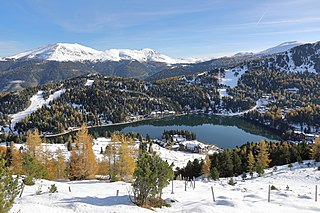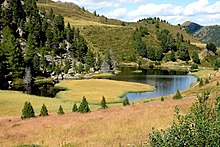
Lake Ossiach is a lake in the Austrian state of Carinthia. It is the state's third largest lake after Lake Wörth and Lake Millstatt.
Bezirk Spittal an der Drau is an administrative district (Bezirk) in the state of Carinthia, Austria.

The Noric Alps is a collective term denoting various mountain ranges of the Eastern Alps. The name derives from the ancient Noricum province of the Roman Empire on the territory of present-day Austria and the adjacent Bavarian and Slovenian area.

The Radstadt Tauern are a subrange of the Central Eastern Alps in Austria. Together with the Schladming Tauern, the Rottenmann and Wölz Tauern and the Seckau Tauern the Radstadt Tauern form the major range of mountains known as the Low Tauern. The mountains are found in the southeast of the Austrian state of Salzburg, between the upper reaches of the Enns and Mur rivers.

Lake Millstatt is a lake in Carinthia, Austria.

Katschberg Pass is a high mountain pass in the Central Eastern Alps in Austria between Rennweg am Katschberg in the state of Carinthia and Sankt Michael im Lungau in Salzburg.

Bad Kleinkirchheim is a municipality and spa town in the district of Spittal an der Drau, in Carinthia, Austria.

Ossiach is a municipality in the Feldkirchen District in the Austrian state of Carinthia. The small settlement is mainly known for Ossiach Abbey.

Krems in Kärnten is a municipality in the district of Spittal an der Drau in Carinthia in Austria.

Rennweg am Katschberg is a market town in the district of Spittal an der Drau in Carinthia, Austria.

Lake Turrach is an Alpine lake at Turracher Höhe Pass, on the state border of Carinthia and Styria in Austria.

The Ankogel Group is a sub-group of the Central Eastern Alps. Together with the Goldberg Group, the Glockner Group, the Schober Group, the Kreuzeck Group, the Granatspitze Group, the Venediger Group, the Villgraten Mountains and the Rieserferner Group it forms the mountain range of the Hohe Tauern.

The Eisenhut is a mountain in the Central Eastern Alps located in Austria. At 2,441 metres (8,009 ft), it is the highest peak of the Gurktal Alps and the Carinthian-Styrian Alps.

The Gurktal Alps is a mountain range in the Central Eastern Alps in Austria which is named after the valley of the Gurk river. The range stretches west to Lake Millstatt and east to Neumarkter Sattel. The highest peak is Eisenhut at 2,441m .

The Lavanttal Alps are part of the Central Eastern Alps in Austria and Slovenia, between the river Mur in the north and the Drava in the south.

The word Tauern is German and originally meant 'high mountain pass' in the Austrian Central Alps, referring to the many bridleways and passes of the parallel side valleys of the River Salzach that cut into the mountain ranges. From the Middle Ages, when mining reached its heyday, the word Tauern was also used to name the corresponding ranges. The name has survived in many local placenames today.

Großer Hafner is a 3,076 m (10,092 ft) high partly-glaciated mountain of the Ankogel Group in the High Tauern range, located at the border between the Austrian states of Carinthia and Salzburg. It is the easternmost three-thousander peak of the range, and also in the entire Alps.

The Großer Rosennock is, at 2,440 m AA (8,010 ft), the second highest of the Gurktal Alps in Carinthia, Austria, after the Eisenhut, which is just one meter higher.

The Reisseck Group or Reißeck Group is a small mountain sub-range in the Austrian state of Carinthia. As the southern part of the Ankogel Group, it belongs to the High Tauern range of the Central Eastern Alps.
Nockberge National Park was a 184 km2 / 23.3 km national park in Upper Carinthia, Nockberge in Austria. It was established in 1987 and dissolved in 2012. In July 2012, it was converted into Salzburger Lungau und Kärntner Nockberge, a UNESCO designated biosphere reserve.





















